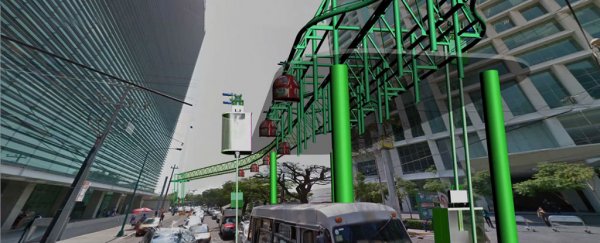However terrible your morning commute is, it's unlikely that you have it quite as bad as the drivers of Mexico City. According to the TomTom Traffic Index, it's the second worst city in the world - behind Istanbul - for road congestion. You're looking at delays of around 30 minutes every day if your commute lasts 30 minutes - in other words, spending twice as long on the road as you should need to.
Now the local authorities think they've found a solution to the problem: an aerial transportation system, built around gondolas that carry passengers above the snarling traffic, the poorly maintained road network, and the street protests that happen on a regular basis. The elevated monorail idea has been floated by SECITI - the city's Ministry of Science, Technology and Innovation.
SECITI says that a 3-mile (4.8-km) line could potentially shift 37 million passengers a year, and that figure could rise to 200 million if the line was extended to 10 miles (16 km). Compare that with Mexico City's busiest subway line, which carries 290 million passengers a year, and we're talking about a substantial number of people drifting serenely above the road network.
The compact two-seater gondolas would be highly efficient in the way they operate too. Each pair of passengers would indicate where they were heading, enabling the carriages to breeze past stations they didn't need to stop at and change to different lines when required. They'll move at a speed of around 9 mph (14 km/h), which sounds crazy slow, but they'd be easily outpacing the average traffic speed of just under 5 mph (8 km/h) as they made their way around the urban metropolis.
By taking advantage of a special gravitational lifting system, electricity use could be minimised, which means less of a draw on the local power network. If you want to see the system in operation (and test your Spanish at the same time), watch the computer animated video below to get a sense of how the system would work in practice.
Now all that's required is enough money to pay for it. SECITI officials estimate that building the aerial gondola system will cost 10 times less than constructing subway tunnels across the same sized area, and it should also be around 40 percent cheaper to maintain than the existing metro system. Still, at a cost of $9-19 million per kilometre of track, both public and private investors will probably have to get involved to get the project off the ground.
